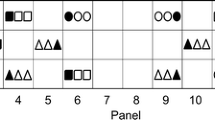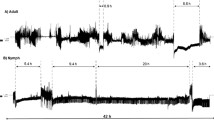Abstract
Grapevine leafroll–associated virus-3 (GLRaV-3) is transmitted from infected grapevines to healthy vines by mealybugs. The stylet penetration behaviour of Pseudococcus longispinus (Hemiptera: Pseudococcidae) was electronically monitored on leaves of grape plants to quantify the time taken to access the phloem and the duration of phloem ingestion. More of the first instar nymphs than of the adults showed sustained (>10 min) phloem ingestion; however, nymphs were affected adversely by longer monitoring periods. The probing and phloem ingestion periods of adults on GLRaV-3-infected Red Globe and uninfected Pinot noir were not significantly different from each other. Most adults showed the first phloem ingestion and the first sustained phloem ingestion after 12 h and after 24 h of their first probe, respectively. Free (unwired) and electrical penetration graph (EPG)-monitored (wired) P. longispinus adults were tested for acquisition of virus after different acquisition access periods (AAP). Acquired GLRaV-3 RNA in extracts of whole insects was detected by reverse transcription and polymerase chain reaction amplification. For the unwired adult mealybugs, 30 % that had an AAP of 48 h and 90 % that had an AAP of 72 or 96 h were positive for GLRaV-3. Five out of 24 (21 %) of the wired mealybugs allowed at least 24 h APP (1.8–44.4 h of phloem ingestion) were positive for GLRaV-3. None of the adult mealybugs acquired virus during the first 24 h of AAP. We conclude that GLRaV-3 acquisition by P. longispinus generally occurs within 24–72 h AAP with as little as 1.8 h of phloem ingestion.




Similar content being viewed by others
References
Almeida RPP, Tsai C, Daane KM (2009) The role of seasonality on mealybug transmission of grapevine leafroll-associated viruses: an ecological hypothesis. In: 16th meeting of the international council for the study of virus and virus-like diseases of the grapevine, pp 278
Bell VA, Bonfiglioli RGE, Walker JTS, Lo PL, Mackay JF, McGregor SE (2009) Grapevine leafroll-associated virus 3 persistence in Vitis vinifera remnant roots. J Plant Pathol 91:527–533
Cabaleiro C (1997) Field transmission of grapevine leafroll associated virus 3 (GLRaV-3) by the mealybug Planococcus citri. Plant Dis 81:283–287
Cabaleiro C, Segura A (1997) Some characterisics of the transmission of grapevine leafroll associated virus 3 by Planococcus citri Risso. Eur J Plant Pathol 103:373–378
Calatayud P, Le Rü B (2006) Feeding behaviour. In: Cassava–mealybug interactions, pp 31–35
Calatayud PA, Rahbé Y, Tjallingii WF, Tertuliano M, Le Rü B (1994) Electrically recorded feeding behaviour of cassava mealybug on host and non-host plants. Entomol Exp Appl 72:219–232
Charles JG (1981) Distribution and life-history of the longtailed mealy bug, pseudococcus-longispinus (Homoptera, Pseudococcidae), in Auckland Vineyards. New Zeal J Zool 8:285–293
Charles J G, Jordan, DT (1993). Mealybugs associated with grapevine leafroll disease (GLR). In Proceedings of the New Zealand grape and wine symposium, New Zealand Society of Viticulture and Oenology, pp 31–34
Charles JG, Cohen D, Walker JTS, Forgie SA, Bell VA, Breen KC (2006) A review of the ecology grapevine leafroll associated virus type 3 (GLRaV-3). N Z Plant Protect 59:330–337
Charles JG, Froud KJ, van den Brink R, Allan DJ (2009) Mealybugs and the spread of grapevine leafroll associated virus type 3 (GLRaV-3) in a New Zealand vineyard. Australas Plant Path 38:576–583
Cid M, Fereres A (2010) Characterization of the probing and feeding behaviour of Planococcus citri (Hemiptera: Pseudococcidae) on grapevine. Ann Entomol Soc Am 103:404–417
Cid M, Pereira S, Cabaleiro C (2007) Presence of grapevine leafroll-associated virus 3 in primary salivary glands of the mealybug vector Planococcus citri suggests a circulative transmission mechanism. Eur J Plant Pathol 118:23–30
Cohen D, Brink VD, Habili N (2004) Detection of leafroll virus in newly infected grapevines. The Australian & New Zealand Grapegrower & Winemaker. Annu Tech Issue 498:56–59
Cox JM (1977) Survey of mealybug species (Homoptera: Pseudococcidae) in Auckland orchards and vineyards. New Zeal J Agric Res 20:259–261
Credi R, Terlizzi F, Martini L, Borsari S (2009) Transmission trails of grapevine viruses by the mealybug Planococcus ficus (Hemiptera: Pseudococcidae). In: 16th meeting of the international council for the study of virus and virus-like diseases of the grapevine pp 285
Daane KM, Cooper ML, Triapitsyn SV, Walton VM, Yokota GY, Haviland DR, Bentley WJ, Godfrey KE, Wunderlich LR (2008) California vineyard managers and researchers seek sustainable solutions for mealybugs, a changing pest complex. Calif Agric 62:167–176
Dolja VV (2009) New developments in understanding gene functions and evolution of the grapevine closteroviruses. In: 16th meeting of the international council for the study of virus and virus-like diseases of the grapevine, pp 29–31
Douglas N, Krüger K (2008) Transmission efficiency of grapevine leafroll-associated virus 3 (GLRaV-3) by the mealybugs Planococcus ficus and Pseudococcus longispinus (Hemiptera: Pseudococcidae). Eur J Plant Pathol 122:207–212
Fereres A, Collar JL (2001) Analysis of Noncirculative transmission by electrical penetration graphs. In: Harris KF, Smith OP, Duffus JE (eds) Virus-insect-plant interactions. Academic Press, USA, pp 87–109
Fuchs M, Marsella-Herrick P, Loeb GM, Martinson TE, Hoch HC (2009) Diversity of ampeloviruses in mealybug and soft scale vectors and in grapevine hosts from leafroll-affected vineyards. Phytopathology 99:1177–1184
Golino DA, Almeida R (2008) Studies needed of vectors spreading leafroll disease in California vineyards. Calif Agric 62:174–176
Golino DA, Sim ST, Gill R, Rowhani A (2002) California mealybugs can spread grapevine leafroll disease. Calif Agric 56:196–201
Grasswitz TR, James DG (2008) Movement of grape mealybug, Pseudococcus maritimus, on and between host plants. Entomol Exp Appl 129:268–275. doi:10.1111/j.1570-7458.2008.00786.x
Hommay G, Le Maguet J, Komar V, Lemaire O, Herrbach E (2009) Transmission of grapevine leafroll-associated virus-1 and -3 (Ampelovirus) and grapevine virus A (Vitivirus) by natural populations of soft scales and mealybugs in the North-Eastern French vineyard. In: 16th meeting of the international council for the study of virus and virus-like diseases of the grapevine
Huang F, Tjallingii WF, Zhang P, Zhang J, Lu Y, Lin J (2012) EPG waveform characteristics of solenopsis mealybug stylet penetration on cotton. Entomol Exp Appl 143:47–54
Krüger K, Saccaggi D, Douglas N (2006) Grapevine Leafroll-associated virus 3- vector interactions: transmission by the mealybugs Planococcus ficus and Pseudococcus longispinus (Hemiptera: Pseudococcidae). In: 15th meeting of the international council for the study of virus and virus-like diseased of grapevine (ICVG)
La Notte P, Buzkan N, Choueiri E, Minafra A, Martelli GP (1997) Acquisition and transmission of grapevine virus A by the mealybug Pseudococcus longispinus. J Plant Pathol 78:79–85
Le Maguet J, Beuve M, Herrbach E, Lemaire O (2012) Transmission of six ampeloviruses and two vitiviruses to grapevine by Phenacoccus aceris. Phytopathology 102:717–723
Lo PL, Bell VA, Walker JTS, Cole LC, Rogers DJ, Charles JG (2006). Ecology and management of mealybugs in vineyards, 2005–2006. HortResearch client report no. 19636, The Horticulture and Food Research Institute of New Zealand, Auckland, New Zealand
MacKenzie DJ, McLean MA, Mukerji S, Green M (1997) Improved RNA extraction from woody plants for the detection of viral pathogens by reverse transcription-polymerase chain reaction. Plant Dis 81:222–226
Mahfoudhi N, Digiaro M, Dhouibi MH (2009) Transmission of Grapevine Leafroll Viruses by Planococcus ficus (Hemiptera: Pseudococcidae) and Ceroplastes rusci (Hemiptera: Coccidae). Plant Dis 93:999–1002
Martelli GP, Boudon-Padieu E (2006) Directory of infectious diseases of grapevines. Options Méditerranéennes, Série B, 55: CIEHAM-IAM Bari
Martelli GP, Agranovsky AA, Bar-Joseph M, Boscia D, Candresse T, Coutts RHA, Dolja VV, Falk BW, Gonsalves D, Jelkmann W, Karasev AV, Minafra A, Namba S, Vetten HJ, Wisler GC, Yoshikawa N (2002) The family Closteroviridae revised. Arch Virol 147:2039–2044
McKissock A (1964) Two important virus diseases of grapevines in New Zealand. New Zeal J Agric Res 108:332–339
McLean DL, Kinsey MG (1964) A technique for electronically recording aphid feeding and salivation. Nature (Lond.) 202:1358–1359
Ng JCK, Falk BW (2006) Virus-vector interactions mediating nonpersistent and semipersistent transmission of plant viruses. Annu Rev Phytopathol 44:183–212
Petersen CL, Charles JG (1997) Transmission of grapevine leafroll-associated closteroviruses by Pseudococcus longispinus and P. calceolariae. Plant Pathol 46:509–515
Petersen CL, Jordan DT (1992) ELISA works well for the identification of leafroll. In: Proceedings of the New Zealand grape and wine symposium, New Zealand Society of Viticulture and Oenology, pp 54–55
Prado E, Tjallingii WF (1994) Aphid activities during sieve element punctures. Entomol Exp Appl 72:157–165
Scheller HV, Shukle RH (1986) Feeding behavior and transmission of barley yellow dwarf virus by Sitobion avenae on oats. Entomol Exp Appl 40:189–195
Tjallingii WF (1978) Mechanoreceptors of the aphid labium. Entomol Exp Appl 24:731–737
Tjallingii WF (2000) Comparison of AC and DC systems for electronic monitoring of stylet penetration activities by homopterans. In: Walker GP, Backus EA (eds) Principles and applications of electronic monitoring and other techniques in the study of homopteran feeding behavior. Thomas Say Publications in Entomology, Entomological Society of America, Lanham
Tjallingii WF, Prado E (2001) Analysis of circulative transmission by electrical penetration graphs. In: Harris KF, Smith OP, Duffus JE (eds) Virus-insect-plant interactions. Academic Press, USA, pp 69–85
Tsai CW, Chau J, Fernandez L, Bosco D, Daane KM, Almeida RPP (2008) Transmission of grapevine leafroll-associated virus 3 by the vine mealybug (Planococcus ficus). Phytopathology 98:1093–1098
Acknowledgments
We thank Gordon Grandison for providing virus-infected plant material, Robert Edwards for technical help and John Charles and Robin MacDiarmid for their valuable comments on the manuscript. Funding was provided by The New Zealand Institute for Plant & Food Research Limited and International Science and Technology travel fund (ISAT B08-39).
Author information
Authors and Affiliations
Corresponding author
Additional information
Handling Editor: Heikki Hokkanen.
Rights and permissions
About this article
Cite this article
Sandanayaka, W.R.M., Blouin, A.G., Prado, E. et al. Stylet penetration behaviour of Pseudococcus longispinus in relation to acquisition of grapevine leafroll virus 3. Arthropod-Plant Interactions 7, 137–146 (2013). https://doi.org/10.1007/s11829-012-9238-8
Received:
Accepted:
Published:
Issue Date:
DOI: https://doi.org/10.1007/s11829-012-9238-8




